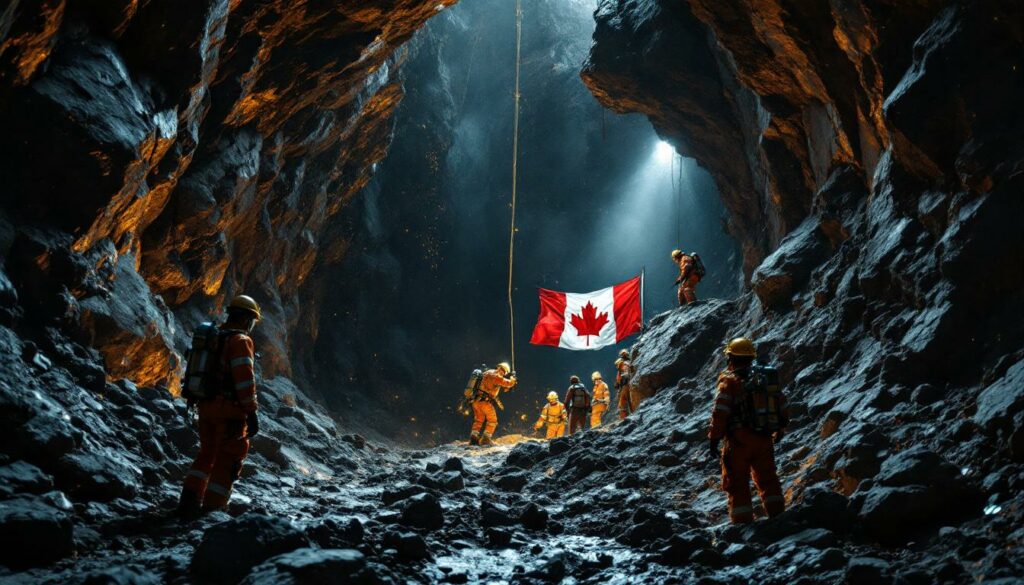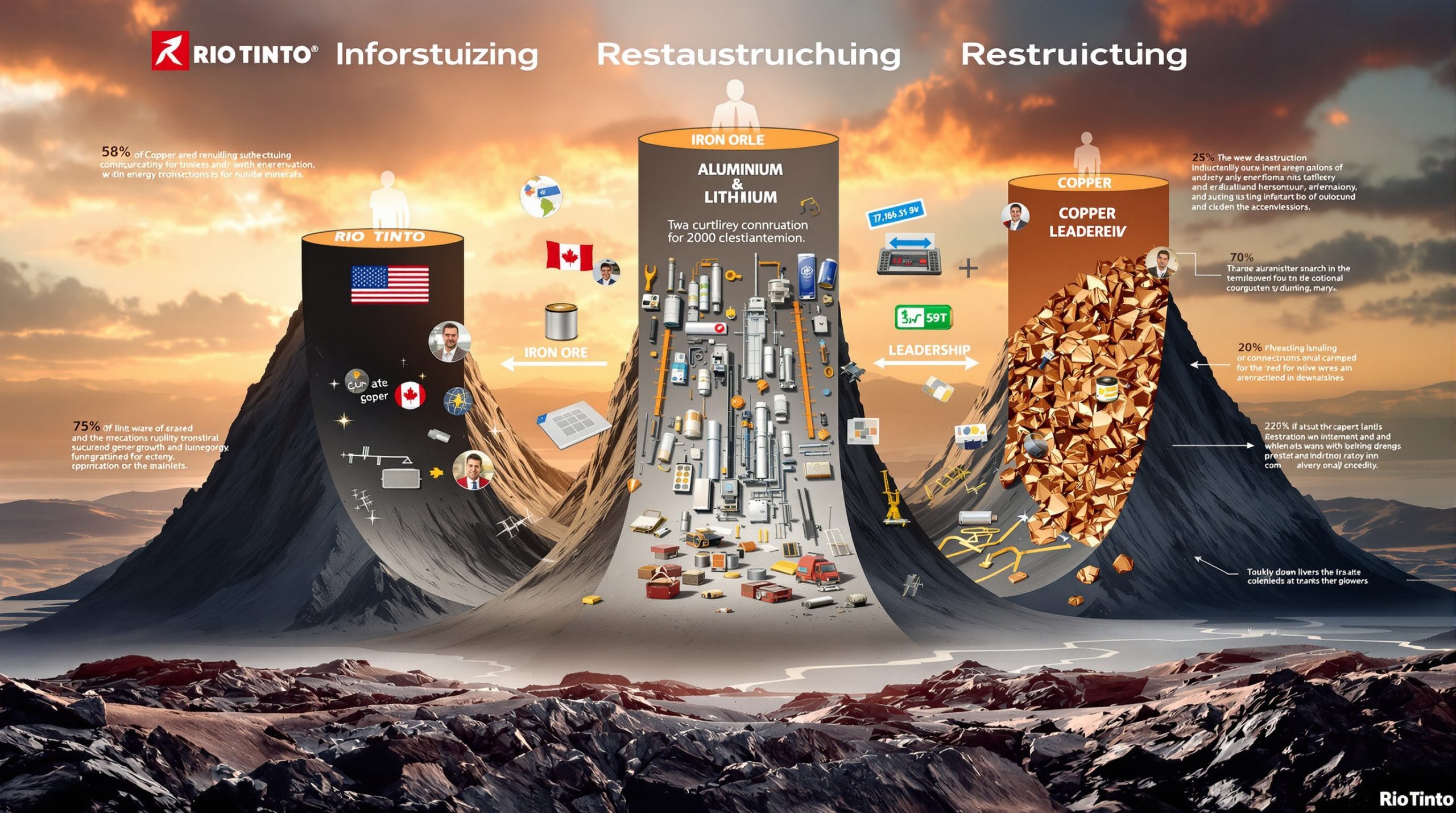What Happened at the Red Chris Mine Rescue?
In a successful rescue operation at Newmont's Red Chris gold and copper mine in British Columbia, three workers from Hy-Tech Drilling were safely extracted after being trapped underground due to a fall of ground incident. The incident, which occurred on Wednesday, July 24, 2025, led to a temporary suspension of operations at the mine while rescue efforts were underway.
The specialized rescue team worked tirelessly through challenging conditions to reach the trapped miners, maintaining communication throughout the operation. After approximately 48 hours underground, all three workers were brought to the surface on Friday, July 26, with no life-threatening injuries reported.
"The health and safety of our workforce remains our top priority," said a Newmont spokesperson following the rescue. "We will conduct a comprehensive investigation into this incident to determine the cause and implement measures to prevent similar occurrences in the future."
Timeline of the Incident
- Wednesday, July 24: A fall of ground incident occurred during drilling operations, trapping three Hy-Tech Drilling workers underground
- Wednesday-Friday: Rescue teams worked continuously while mine operations remained suspended
- Friday, July 26: All three workers were successfully rescued and brought to the surface
- Post-rescue: Medical evaluation and monitoring of the rescued workers commenced
Company Response
Newmont immediately activated its emergency response protocol following the incident, deploying specialized rescue teams equipped with advanced technology to locate and extract the trapped workers. The company maintained regular communication with the workers' families throughout the rescue operation.
The incident has prompted a thorough review of safety protocols at the Red Chris mine, with particular focus on geotechnical assessments and ground support systems in areas where drilling contractors operate.
Why Mine Safety Incidents Matter in the Industry
Mine safety incidents extend far beyond the immediate human impact, affecting multiple facets of mining operations and the industry as a whole. The Red Chris incident highlights the critical importance of robust safety systems in modern mining operations.
According to a 2022 study published in the Mining Journal, major safety incidents can cost mining companies between $10 million and $50 million in direct costs alone, not including potential long-term impacts on production and reputation.
Impact on Operations and Production
When safety incidents occur, the operational effects ripple throughout the mining enterprise:
- Production losses: The two-day suspension at Red Chris represents significant output reduction
- Project timeline disruptions: Underground development work faces setbacks
- Financial implications: Beyond immediate costs, insurance premiums often increase
- Workforce confidence: Safety incidents can affect employee morale and retention
For large-scale operations like Red Chris, production disruptions can amount to millions in lost revenue, affecting not just the company but also contractors, suppliers, and local economies dependent on mining activity.
Regulatory and Safety Protocol Considerations
Safety Standards in Canadian Mining
Canadian mining operations operate under some of the world's most stringent safety frameworks, which include:
- The Mines Act: Establishes foundational requirements for mine safety in British Columbia
- Health, Safety and Reclamation Code for Mines in British Columbia: Provides detailed guidance for operational safety
- WorkSafeBC requirements: Mandates incident reporting within 24-48 hours and independent investigations
- Technical Safety BC: Oversees equipment safety and certification
These frameworks are continuously updated based on incident investigations and technological advancements, creating a regulatory environment that evolves with BC mining framework.
Post-Incident Procedures
Following incidents like the one at Red Chris, mining companies must follow established protocols:
- Immediate rescue and medical response
- Temporary suspension of related activities
- Scene preservation for investigation
- Incident reporting to regulatory authorities
- Root cause analysis
- Implementation of corrective measures
- Regulatory inspection and compliance verification
- Industry-wide sharing of lessons learned
These procedures ensure not only compliance with regulations but also contribute to the continuous improvement of safety standards across the industry.
Who Operates the Red Chris Mine?
Newmont's Ownership and Operation
Red Chris is operated by Newmont Corporation, one of the world's largest gold mining companies with annual production exceeding 10 million ounces of gold. The company has established itself as a major player in the global mining industry, with operations spanning multiple continents.
Located in northwestern British Columbia, approximately 80 kilometers south of Dease Lake, the Red Chris mine sits within the traditional territories of the Tahltan First Nation. Newmont has maintained active consultation and collaboration with indigenous communities throughout the mine's development and operation.
The company acquired the Red Chris mine as part of its strategic expansion into copper-gold operations, recognizing the growing importance of copper in renewable energy technologies and electric vehicles.
Mine Characteristics and Production
Red Chris stands out in Newmont's portfolio for several key characteristics:
- Combined mining approach: Originally developed as an open-pit operation, the mine has expanded to include underground development
- Significant reserves: The deposit contains substantial gold and copper resources with a mine life extending into the 2030s
- Block cave mining: The underground expansion utilizes block caving, a highly efficient bulk mining method
- Processing capacity: The mill processes approximately 30,000 tonnes of ore daily
- Infrastructure: The operation includes power generation facilities, maintenance shops, and environmental management systems
The mine represents a significant investment in British Columbia's mining sector, contributing to regional employment and economic development.
Contractor Involvement
Hy-Tech Drilling, whose workers were involved in the incident, specializes in deep-hole drilling and ground support systems critical for stability in underground mining. As a contractor at Red Chris, Hy-Tech provides specialized drilling services that complement Newmont's core mining operations.
The use of specialized contractors is standard practice in the mining industry, allowing companies to access technical expertise and equipment without maintaining these specialized capabilities in-house. This arrangement requires careful coordination of safety protocols and responsibilities between the mine operator and contractors.
How Do Mining Companies Handle Underground Emergencies?
Emergency Response Protocols
Modern mining operations maintain comprehensive emergency response systems designed to address a wide range of potential incidents:
- Mine rescue teams: Specially trained personnel with expertise in underground rescue operations
- Communication protocols: Clear chains of command and communication procedures during emergencies
- Regular drills: Leading mines conduct 4-6 emergency simulations annually to maintain readiness
- Coordination with external services: Established relationships with local emergency responders
- Family liaison systems: Dedicated personnel to communicate with families during incidents
These protocols are regularly reviewed and updated based on lessons learned from incidents and near-misses both within the company and across the industry.
Technology in Mine Safety and Rescue
Technological advancements have significantly improved mine safety and rescue capabilities:
- Seismic detection systems: Used to locate trapped miners via vibration signals
- Refuge chambers: Provide 72-hour air supply and communication systems for trapped miners
- Communication infrastructure: Systems designed to function even when main power is compromised
- Tracking technologies: RFID and similar systems to locate personnel underground
- Atmospheric monitoring: Real-time detection of hazardous gases and oxygen levels
- Robotics and drones: Remote assessment of unstable areas before human entry
At advanced operations like Red Chris, these technologies form an integrated safety system that both prevents incidents and enables rapid response when they do occur.
Industry Best Practices
The mining industry has developed numerous best practices for emergency response:
"Emergency preparedness isn't just about having the right equipment—it's about creating a culture where safety protocols become second nature to every worker underground." — Mining Safety Leadership Forum, 2023
Key elements of industry best practice include:
- Regular training cycles: Ensuring all personnel understand emergency procedures
- Tabletop exercises: Testing decision-making processes without physical deployment
- Multi-company drills: Collaborative exercises that test mutual aid agreements
- After-action reviews: Detailed analysis of response effectiveness following drills or actual events
- Technology integration: Ensuring systems work together seamlessly during emergencies
These practices are shared through industry associations and safety forums, creating a collective approach to emergency preparedness that drives industry innovation trends.
What Are the Common Causes of Underground Mine Incidents?
Geological Factors
Underground mining inherently involves working in dynamic geological environments that present various hazards:
- Rock bursts: Sudden, violent fracturing of rock due to stress release, accounting for approximately 30-40% of underground incidents
- Structural weakness: Natural faults and joints that can compromise stability
- Water inflows: Unexpected groundwater sources that can flood workings
- Ground pressure changes: Alterations in stress distribution as mining progresses
- Geological anomalies: Unexpected changes in rock type or structure
Mining companies employ geologists and geotechnical engineers to assess these risks, but the underground environment remains inherently unpredictable.
Operational Factors
Human and operational elements that can contribute to incidents include:
- Equipment failures: Mechanical breakdowns of critical systems
- Procedural lapses: Deviations from established safety protocols
- Communication breakdowns: Misunderstandings between shifts or departments
- Inadequate ground support: Insufficient or improperly installed support systems
- Ventilation issues: Problems with air quality or circulation
- Blasting effects: Unintended consequences of explosive use
These factors often interact with geological conditions, creating complex risk scenarios that require multifaceted prevention strategies.
Prevention Strategies
Modern mining operations employ multiple approaches to prevent underground incidents:
- Advanced monitoring: Microseismic systems that detect subtle rock movements
- LiDAR scanning: Regular 3D mapping to identify changes in tunnel geometry
- Stress modeling: Computer simulations to predict how mining activities will affect rock stability
- Ground support regimes: Engineered systems of bolts, mesh, and shotcrete
- Proactive destressing: Controlled blasting to release rock pressure gradually
- Water management plans: Systems to detect and control water inflows
- Comprehensive training: Ensuring all personnel can recognize warning signs
These strategies are most effective when implemented as part of a holistic safety system that combines technology, training, and organizational culture.
How Does This Incident Compare to Other Mining Rescues?
Notable Mining Rescues in Recent History
The Red Chris incident joins a history of mining rescues that have captured public attention:
| Incident | Location | Year | Duration | Outcome |
|---|---|---|---|---|
| Copiapó | Chile | 2010 | 69 days | 33 miners rescued |
| Red Chris | Canada | 2025 | 2 days | 3 miners rescued |
| Lily Mine | South Africa | 2015 | Ongoing | 3 miners never recovered |
| Hushan Gold Mine | China | 2021 | 14 days | 11 rescued, 10 died |
| Brumadinho Dam | Brazil | 2019 | N/A | 270 fatalities |
The relatively short duration of the Red Chris rescue (2 days versus 69 days at Copiapó) reflects improvements in rescue technology, emergency preparedness, and possibly the nature of the incident itself, as detailed in this report.
Factors Affecting Rescue Success
Several critical factors influence the outcome of mining rescue operations:
- Depth and location: The Red Chris incident occurred at an accessible depth, unlike some deeper mining incidents
- Structural stability: The area around the trapped workers remained relatively stable
- Communication: Contact was maintained with the trapped workers throughout the incident
- Available resources: Newmont deployed significant resources immediately
- Rescue team expertise: Specialized training in underground rescue techniques
- Time factors: Rapid response within the critical first 24 hours
These factors combined to create favorable conditions for a successful rescue at Red Chris, contrasting with more challenging scenarios like the Lily Mine collapse where structural instability has prevented recovery to this day.
What Safety Measures Are Critical in Underground Mining?
Engineering Controls
Physical safety measures in modern mines form the first line of defense against incidents:
- Ground support systems: Combinations of rock bolts (typically 1.8-3.0 meters long), wire mesh, friction bolts, and shotcrete
- Ventilation networks: Primary and secondary systems providing 100-200 cubic feet per minute of fresh air per person
- Water management: Pumping systems capable of handling unexpected inflows
- Fire suppression: Automated systems with heat detection in high-risk areas
- Refuge chambers: Self-contained units with 36-72 hours of air, water, and communications
- Secondary egress: Multiple escape routes from underground workings
These engineering controls are designed with redundancy to ensure function even when primary systems fail.
Administrative Controls
Procedural and management controls complement physical systems:
- Job safety analyses: Detailed risk assessments for specific tasks
- Permit systems: Formal approval processes for high-risk activities
- Inspection regimes: Regular scheduled examinations of critical areas
- Management of change: Formal processes for evaluating alterations to procedures or systems
- Contractor management: Coordination of safety standards across multiple companies
- Shift handover protocols: Structured information transfer between crews
When properly implemented, these administrative controls create multiple layers of protection against potential incidents.
Training and Preparedness
Personnel preparedness remains essential for mine safety:
- Basic training: Comprehensive safety orientation for all underground workers
- Task-specific training: Specialized instruction for particular roles
- Emergency response drills: Regular practice of evacuation and rescue procedures
- First aid certification: Medical response capabilities distributed throughout the workforce
- Mental health awareness: Recognition of psychological factors in safety performance
- Leadership development: Safety-focused management training
This training creates a workforce capable of both preventing incidents and responding effectively when they occur, with many companies now incorporating mining mental health support into their safety programs.
What Are the Implications for the Mining Industry?
Learning Opportunities
The Red Chris incident, like all safety events, provides valuable learning opportunities:
- Incident investigation: Detailed analysis of root causes and contributing factors
- Technology assessment: Evaluation of monitoring systems' effectiveness
- Emergency response review: Analysis of rescue operation efficiency
- Contractor integration: Examination of safety protocol alignment between companies
- Industry knowledge sharing: Distribution of lessons learned to prevent similar incidents
These learning opportunities extend beyond Newmont to benefit the broader mining industry through improved data-driven mining operations.
Regulatory Considerations
Safety incidents often prompt regulatory review and potential policy changes:
- Inspection focus: Increased attention to ground control in similar operations
- Guidance updates: Revised best practice documents from regulatory authorities
- Reporting requirements: Potential enhancement of incident notification standards
- Contractor oversight: Examination of responsibility allocation between operators and service providers
- Training standards: Review of qualification requirements for specialized activities
WorkSafeBC and the BC Ministry of Energy, Mines and Low Carbon Innovation will likely review the incident for potential regulatory implications.
Public Perception and Social License
How mining companies respond to safety incidents significantly affects their social license to operate:
- Transparency: Open communication about the incident and response
- Accountability: Clear acceptance of responsibility and commitment to improvement
- Community engagement: Involving local stakeholders in safety discussions
- Indigenous relationships: Particularly important in regions like British Columbia with significant First Nations interests
- Media management: Providing accurate information to counter misinformation
Newmont's handling of the Red Chris incident will influence not only its own reputation but potentially public perception of the mining industry more broadly.
FAQs About Mine Safety and Rescue Operations
What causes "fall of ground" incidents in mines?
Fall of ground incidents occur when rock or soil from the roof or walls of a mine opening becomes unstable and collapses. These can be caused by geological stress, inadequate ground support, blasting activities, or natural geological weaknesses. According to the International Journal of Rock Mechanics and Mining Sciences, approximately 40% of mining fatalities worldwide are attributed to ground falls, making them one of the most significant hazards in underground operations.
Prevention relies on comprehensive geotechnical assessment, appropriate support systems, and regular monitoring. Modern mines employ microseismic monitoring to detect subtle rock movements that might precede a major fall.
How do trapped miners typically survive underground?
Survival underground depends on several factors including access to breathable air, water, food, and protection from hazards. Modern mines are equipped with refuge chambers that provide air, water, and basic supplies. These chambers typically contain:
- Compressed air or oxygen generation systems
- Carbon dioxide scrubbers to maintain air quality
- Emergency food and water supplies
- Communication equipment
- First aid supplies
- Psychological support materials
Miners are trained to conserve resources and follow emergency protocols while awaiting rescue. In incidents like Red Chris, where rescue occurred within 48 hours, the primary concerns are typically air quality and psychological well-being rather than food or water supplies.
What technologies are most effective in mine rescue operations?
Effective rescue technologies include specialized communication systems that can penetrate rock, seismic listening devices to locate trapped miners, drilling equipment for creating rescue shafts, and advanced breathing apparatus for rescue teams. Increasingly, robotics and drones are being used to assess dangerous areas before human rescuers enter.
Communication technologies are particularly critical, with through-the-earth radio systems capable of transmitting messages through hundreds of meters of rock. These systems allow rescue teams to coordinate with trapped miners, gathering vital information about conditions and planning the most effective
Seeking Early Alerts for ASX Mineral Discoveries?
Discover how Discovery Alert's proprietary Discovery IQ model provides real-time notifications of significant mineral discoveries on the ASX, giving traders and investors a crucial market advantage. Visit the Discovery Alert discoveries page to explore historic returns from major mineral finds and begin your 30-day free trial today.




